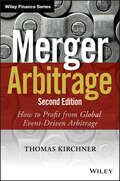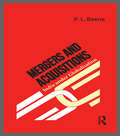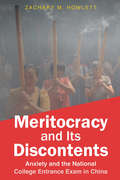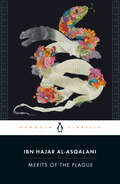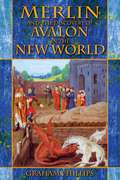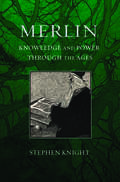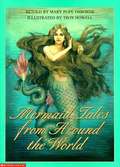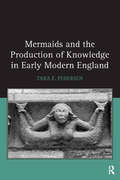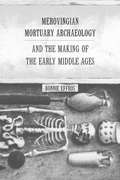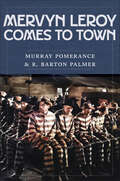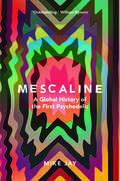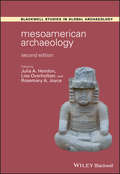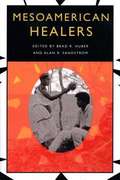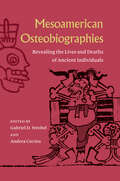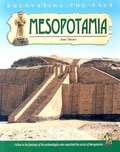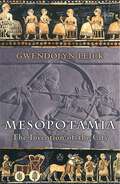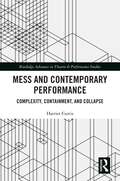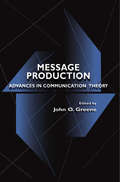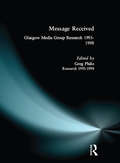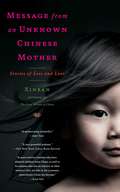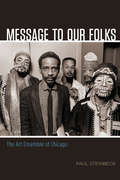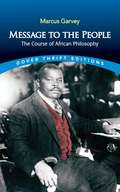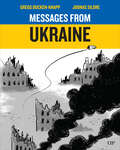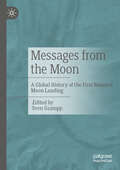- Table View
- List View
Merger Arbitrage: How to Profit from Global Event-Driven Arbitrage
by Thomas KirchnerMitigate risk and increase returns with an alternative hedge fund strategy Merger Arbitrage: How to Profit from Event-Driven Arbitrage, Second Edition is the definitive guide to the ins and outs of the burgeoning merger arbitrage hedge fund strategy, with real-world examples that illustrate how mergers work and how to take advantage of them. Author Thomas Kirchner, founder of the Pennsylvania Avenue Event-Driven Fund, discusses the factors that drove him to invest solely in merger arbitrage and other event-driven strategies, and details the methods used to incorporate merger arbitrage into traditional investment strategies. And while there is always a risk that a deal will fall through, the book explains how minimal such risks really are when the potential upside is factored in. Early chapters of the book focus on the basics of the merger arbitrage strategy, including an examination of mergers and the incorporation of risk into the arbitrage decision. Following chapters detail deal structures, financing, and legal aspects to provide the type of in-depth knowledge required to execute an effective investment strategy. The updated second edition stresses new, increasingly relevant information like: Worldwide legal deal regimes UK takeover code UK takeover code global offspring Regulators around the world The book provides clear, concise guidance on critical considerations including leverage and options, shorting stocks, and legal recourse for inadequate merger consideration, allowing readers to feel confident about trying a new investment strategy. With simple benefits including diversification of risk and return streams, this alternative hedge fund strategy has a place in even the most traditional plan. Merger Arbitrage: How to Profit from Event-Driven Arbitrage, Second Edition provides the information that gives investors an edge in the merger arbitrage arena.
Mergers and Acquisitions: India under Globalisation
by P. L. BeenaThis book provides a holistic account of developments and patterns of mergers and acquisitions that have taken place in the Indian corporate sector, especially in the post-liberalisation era. It combines astute analyses with up-to-date data to present an all-inclusive picture of globalisation and its impact on business in contemporary India. This will serve as an important resource to researchers, scholars and students of economics, management, business administration, business studies, commerce and corporate law, as well as policy-makers, legal practitioners, industrial houses, and industrial bodies.
Meritocracy and Its Discontents: Anxiety and the National College Entrance Exam in China
by Zachary M. HowlettMeritocracy and Its Discontents investigates the wider social, political, religious, and economic dimensions of the Gaokao, China's national college entrance exam, as well as the complications that arise from its existence. Each year, some nine million high school seniors in China take the Gaokao, which determines college admission and provides a direct but difficult route to an urban lifestyle for China's hundreds of millions of rural residents. But with college graduates struggling to find good jobs, some are questioning the exam's legitimacy—and, by extension, the fairness of Chinese society. Chronicling the experiences of underprivileged youth, Zachary M. Howlett's research illuminates how people remain captivated by the exam because they regard it as fateful—an event both consequential and undetermined. He finds that the exam enables people both to rebel against the social hierarchy and to achieve recognition within it. In Meritocracy and Its Discontents, Howlett contends that the Gaokao serves as a pivotal rite of passage in which people strive to personify cultural virtues such as diligence, composure, filial devotion, and divine favor.
Merits of the Plague
by Ibn Hajar al-AsqalaniThe preeminent meditation on plagues and pandemics from the Islamic world, now in English for the first timeA Penguin ClassicSix hundred years ago, the author of this landmark work of history and religious thought—an esteemed judge, poet, and scholar in Cairo—survived the bubonic plague, which took the lives of three of his children, not to mention tens of millions of others throughout the medieval world. Holding up an eerie mirror to our own time, he reflects on the origins of plagues—from those of the Prophet Muhammad&’s era to the Black Death of his own—and what it means that such catastrophes could have been willed by God, while also chronicling the fear, isolation, scapegoating, economic tumult, political failures, and crises of faith that he lived through. But in considering the meaning of suffering and mass death, he also offers a message of radical hope. Weaving together accounts of evil jinn, religious stories, medical manuals, death-count registers, poetry, and the author&’s personal anecdotes, Merits of the Plague is a profound reminder that with tragedy comes one of the noblest expressions of our humanity: the practice of compassion, patience, and care for those around us.
Merlin and the Discovery of Avalon in the New World
by Graham PhillipsThe first book to present the true identity of the mythic figure Merlin• Uncovers historical evidence that the legend of Merlin was based on the life of a real man• Reveals that Avalon, Merlin’s final resting place, was an island in the United StatesThe legendary figure Merlin is known throughout the world as the wizard of Camelot who was counselor to King Arthur and helped that monarch create the Round Table. Through the course of a 20-year investigation Graham Phillips has uncovered evidence that this famous story was based on the life of an actual historical figure: the son of a Roman consul who became the last of the Romans to rule Britain in the fifth century A.D. Furthermore, the evidence reveals that he died and was buried in what is now the United States.According to legend, Merlin ended his life on the mystical island of Avalon. A 1500-year-old saga tells how Merlin left Britain on a boat bound for a mysterious island to the west. The places described in Merlin’s voyage, Phillips argues, would only have been seen by someone who had journeyed to the New World. For example, the island where boiling fountains bubble from the ground could be the geysers of Iceland, and the island with rivers of ice, the glaciers of Greenland.During his research Phillips discovered that a site believed to be Merlin’s grave was found by the first British settlers in North America: a secret location said to have been preserved in the works of William Shakespeare and the coded writings of the Freemasons. Phillips follows a trail of historical clues that leads ultimately to a mysterious New England tomb. Here a final encrypted message not only reveals the whereabouts of Merlin’s grave but contains evidence that Merlin’s descendants still survive and, through a merger with the Spencer family of Princess Diana, may once again ascend the British throne.
Merlin: Knowledge and Power through the Ages
by Stephen KnightMerlin, the wizard of Arthurian legend, has been a source of enduring fascination for centuries. In this authoritative, entertaining, and generously illustrated book, Stephen Knight traces the myth of Merlin back to its earliest roots in the early Welsh figure of Myrddin. He then follows Merlin as he is imagined and reimagined through centuries of literature and art, beginning with Geoffrey of Monmouth, whose immensely popular History of the Kings of Britain (1138) transmitted the story of Merlin to Europe at large. He covers French and German as well as Anglophone elements of the myth and brings the story up to the present with discussions of a globalized Merlin who finds his way into popular literature, film, television, and New Age philosophy. Knight argues that Merlin in all his guises represents a conflict basic to Western societies-the clash between knowledge and power. While the Merlin story varies over time, the underlying structural tension remains the same whether it takes the form of bard versus lord, magician versus monarch, scientist versus capitalist, or academic versus politician. As Knight sees it, Merlin embodies the contentious duality inherent to organized societies. In tracing the applied meanings of knowledge in a range of social contexts, Knight reveals the four main stages of the Merlin myth: Wisdom (early Celtic British), Advice (medieval European), Cleverness (early modern English), and Education (worldwide since the nineteenth century). If a wizard can be captured within the pages of a book, Knight has accomplished the feat.
Mermaid Tales From Around The World
by Mary Pope OsborneEnchanting tales of sea nymphs from twelve cultures, including Chinese, Iranian, African, and Native American, are eloquently retold by the author in this acclaimed collection.
Mermaids and the Production of Knowledge in Early Modern England
by Tara E. PedersenWe no longer ascribe the term ’mermaid’ to those we deem sexually or economically threatening; we do not ubiquitously use the mermaid’s image in political propaganda or feature her within our houses of worship; perhaps most notably, we do not entertain the possibility of the mermaid’s existence. This, author Tara Pedersen argues, makes it difficult for contemporary scholars to consider the mermaid as a figure who wields much social significance. During the early modern period, however, this was not the case, and Pedersen illustrates the complicated category distinctions that the mermaid inhabits and challenges in 16th-and 17th-century England. Addressing epistemological questions about embodiment and perception, this study furthers research about early modern theatrical culture by focusing on under-theorized and seldom acknowledged representations of mermaids in English locations and texts. While individuals in early modern England were under pressure to conform to seemingly monolithic ideals about the natural order, there were also significant challenges to this order. Pedersen uses the figure of the mermaid to rethink some of these challenges, for the mermaid often appears in surprising places; she is situated at the nexus of historically specific debates about gender, sexuality, religion, the marketplace, the new science, and the culture of curiosity and travel. Although these topics of inquiry are not new, Pedersen argues that the mermaid provides a new lens through which to look at these subjects and also helps scholars think about the present moment, methodologies of reading, and many category distinctions that are important to contemporary scholarly debates.
Merovingian Mortuary Archaeology and the Making of the Early Middle Ages
by Bonnie EffrosThis book makes a major contribution to the study of death and burial in late antique and early medieval society with its long overdue systematic discussion of this mortuary evidence.
Mervyn LeRoy Comes to Town
by Murray Pomerance R. Barton Palmer Tom Conley Mark Osteen Steven Rybin Dominic Lennard Rebecca Bell-Metereau Linda Badley Lawrence Napper Daniel Varndell Adrian Danks David Desser Neil Badmington Matthew Solomon Brenda Austin-Smith Matthew Cipa Kristen Hatch Matthew H. BernsteinMervyn LeRoy Comes to Town is the first book devoted to the career of one of the director/producers who in the early years of sound cinema was instrumental in establishing the Hollywood model of production that would endure for more than half a century. As a director and producer, LeRoy was responsible for turning out more than sixty feature films in a career that spanned five decades; as a studio executive, he contributed substantially to the success of the industry during the challenging period of the Depression and also in the period of realignment and readjustment that followed the end of World War II. This book offers chapters devoted to individual films such as Little Caesar, Waterloo Bridge, 30 Seconds over Tokyo, Gypsy, and Quo Vadis.
Mesa of Sorrows: A History of the Awat'ovi Massacre
by James F. BrooksA scrupulously researched investigation of the mysterious massacre of Hopi Indians at Awat'ovi, and the event's echo through American history. The Hopi community of Awat’ovi existed peacefully on Arizona’s Antelope Mesa for generations until one bleak morning in the fall of 1700—raiders from nearby Hopi villages descended on Awat’ovi, slaughtering their neighboring men, women, and children. While little of the pueblo itself remains, five centuries of history lie beneath the low rises of sandstone masonry, and theories about the events of that night are as persistent as the desert winds. The easternmost town on Antelope Mesa, Awat’ovi was renowned for its martial strength, and had been the gateway to the entire Hopi landscape for centuries. Why did kinsmen target it for destruction? Drawing on oral traditions, archival accounts, and extensive archaeological research, James Brooks unravels the story and its significance. Mesa of Sorrows follows the pattern of an archaeological expedition, uncovering layer after layer of evidence and theories. Brooks questions their reliability and shows how interpretations were shaped by academic, religious and tribal politics. Piecing together three centuries of investigation, he offers insight into why some were spared—women, mostly, and taken captive—and others sacrificed. He weighs theories that the attack was in retribution for Awat’ovi having welcomed Franciscan missionaries or for the residents’ practice of sorcery, and argues that a perfect storm of internal and external crises revitalized an ancient cycle of ritual bloodshed and purification. A haunting account of a shocking massacre, Mesa of Sorrows is a probing exploration of how societies confront painful histories, and why communal violence still plagues us today.
Mescaline: A Global History of the First Psychedelic
by Mike JayA definitive history of mescaline that explores its mind-altering effects across cultures, from ancient America to Western modernity Mescaline became a popular sensation in the mid-twentieth century through Aldous Huxley’s The Doors of Perception, after which the word “psychedelic” was coined to describe it. Its story, however, extends deep into prehistory: the earliest Andean cultures depicted mescaline-containing cacti in their temples. Mescaline was isolated in 1897 from the peyote cactus, first encountered by Europeans during the Spanish conquest of Mexico. During the twentieth century it was used by psychologists investigating the secrets of consciousness, spiritual seekers from Aleister Crowley to the president of the Church of Jesus Christ of Latter-day Saints, artists exploring the creative process, and psychiatrists looking to cure schizophrenia. Meanwhile peyote played a vital role in preserving and shaping Native American identity. Drawing on botany, pharmacology, ethnography, and the mind sciences and examining the mescaline experiences of figures from William James to Walter Benjamin to Hunter S. Thompson, this is an enthralling narrative of mescaline’s many lives.
Mesoamerican Archaeology: Theory and Practice (Wiley Blackwell Studies in Global Archaeology)
by Julia HendonA unique and wide-ranging introduction to the major prehispanic and colonial societies of Mexico and Central America, featuring new and revised material throughout Mesoamerican Archaeology: Theory and Practice, Second Edition, provides readers with a diverse and well-balanced view of the archaeology of the indigenous societies of Mexico and Central America, helping students better understand key concepts and engage with contemporary debates and issues within the field. The fully updated second edition incorporates contemporary research that reflects new approaches and trends in Mesoamerican archaeology. New and revised chapters from first-time and returning authors cover the archaeology of Mesoamerican cultural history, from the early Gulf Coast Olmec, to the Classic and Postclassic Maya, to the cultures of Oaxaca and Central Mexico before and after colonization. Presenting a wide range of approaches that illustrate political, socio-economic, and symbolic interpretations, this textbook: Encourages students to consider diverse ways of thinking about Mesoamerica: as a linguistic area, as a geographic region, and as a network of communities of practice Represents a wide spectrum of perspectives and approaches to Mesoamerican archaeology, including coverage of the Postclassic and Colonial periods Enables readers to think critically about how explanations of the past are produced, verified, and debated Includes accessible introductory material to ensure that students and non-specialists understand the chronological and geographic frameworks of the Mesoamerican tradition Discusses recent developments in the contemporary theory and practice of Mesoamerican archaeology Presents new and original research by a team of internationally recognized contributors Mesoamerican Archaeology: Theory and Practice, Second Edition, is ideal for use in undergraduate courses on the archaeology of Mexico and Central America, as well as for broader courses on the archaeology of the Americas.
Mesoamerican Healers
by Brad R. Huber Alan R. SandstromHealing practices in Mesoamerica span a wide range, from traditional folk medicine with roots reaching back into the prehispanic era to westernized biomedicine. These sometimes cooperating, sometimes competing practices have attracted attention from researchers and the public alike, as interest in alternative medicine and holistic healing continues to grow.<P><P>Responding to this interest, the essays in this book offer a comprehensive, state-of-the-art survey of Mesoamerican healers and medical practices in Mexico and Guatemala. The first two essays describe the work of prehispanic and colonial healers and show how their roles changed over time. The remaining essays look at contemporary healers, including bonesetters, curers, midwives, nurses, physicians, social workers, and spiritualists. Using a variety of theoretical approaches, the authors examine such topics as the intersection of gender and curing, the recruitment of healers and their training, healers' compensation and workload, types of illnesses treated and recommended treatments, conceptual models used in diagnosis and treatment, and the relationships among healers and between indigenous healers and medical and political authorities.
Mesoamerican Osteobiographies: Revealing the Lives and Deaths of Ancient Individuals
by Andrea Cucina Gabriel D. WrobelA rapidly growing approach within bioarchaeology that focuses on understanding people of the past in their sociocultural contexts Drawing from a variety of sites throughout Mesoamerica, this volume presents a collection of osteobiographies, which analyze skeletons and their surroundings alongside historical, archaeological, ethnographic, and other contextual data to better understand the life experiences of individuals. This approach allows for a focus on the processes by which individual social identities are created, negotiated, and altered.In these chapters, contributors address what individual bodies reveal about their societies, what burials can tell us about the ways people were remembered, and what information about disease and health indicates about lifestyles. Each case study compiles a range of available data to gain insights into a specific time and place. Re-creating the lives of individuals from locations in Belize, Mexico, Guatemala, and Honduras, the volume includes descriptions of everyday activities, the social roles of priests and merchants, memorial practices, and many other spheres of human life.Mesoamerican Osteobiographies demonstrates how the diverse, culturally laden, and complex archaeological record of Mesoamerica can uniquely contribute to bioarchaeology, in part due to the region’s many unusual and elaborate mortuary contexts. The different contributions in this volume show that the osteobiography approach can be integrated into existing research frameworks, both in Mesoamerica and around the world, to answer meaningful biocultural questions about the lives and deaths of ancient people. Contributors: Pamela Geller | Satoru Murata | Gabriel D. Wrobel | Carolyn Freiwald | Kirsten Green Mink | David W. Mixter | Ricardo Rodas | Dr. Della Cook | Abigail Meza Peñaloza | Ethan C. Hill | Erik Velásquez García | Jack Biggs | Frederico Zurtuche | Mónica Urquizú | John Robb | María Belén Méndez Bauer | DR Vera Tiesler | Dr. Andrew K. Scherer | DR Melissa S. Murphy | Lourdes Marquez Morfín | Ana Maria Padilla Dorantes | Dr. Andrea Cucina | Paige Wojcik Woolfolk | Eleanor Harrison-Buck | Claire Ebert | Aurora Marcela Pérez-Flórez | Destiny Micklin | Morgan McKenna | Allan Ortega-Muñoz | Kara Fulton | Lexi O'Donnell | Peter Mercier | Omar A. Alcover-Firpi | Mariah Biggs | Prof Jane Buikstra | Katherine Miller Wolf | Keith Prufer | Jaime Awe | D. Eli Mrak | Emily Moes | Douglas J. Kennett | Joshua T. Schnell | Amy Hair | Takeshi Inomata | Mónica Rodriguez Pérez | Ellen Bell | Daniela Triadan | Samantha Sharon Negrete Gutiérrez | Alex Garcia-Putnam | Anna C. Novotny | Marie Danforth | Lisa LeCount | Loa P. Traxler | Rosalba Yasmin Cifuentes Argüello | Shintaro Suzuki | Fernando Gutiérrez Méndez | Samantha Blatt | Mark Robinson | Amy Michael | Sandra Elizalde
Mesopotamia (Excavating the Past)
by Jane ShuterReaders will discover the hidden wonders of Mesopotamia while excavating the past.
Mesopotamia: The Invention of the City (The\a To Z Guide Ser.)
by Gwendolyn LeickSituated in an area roughly corresponding to present-day Iraq, Mesopotamia is one of the great, ancient civilizations, though it is still relatively unknown. Yet, over 7,000 years ago in Mesopotamia, the very first cities were created. This is the first book to reveal how life was lived in ten Mesopotamian cities: from Eridu, the Mesopotamian Eden, to that potent symbol of decadence, Babylon - the first true metropolis: multicultural, multi-ethnic, the last centre of a dying civilization.
Mess and Contemporary Performance: Complexity, Containment, and Collapse (Routledge Advances in Theatre & Performance Studies)
by Harriet CurtisThis book identifies and theorises mess in contemporary performance and argues that mess offers a site from which subjects might mobilise and find agency, even as the complexity (and indeed messiness) of everyday life conditions and contains.Using a queer feminist and intersectional critical framework, this book analyses how established and emerging artists mess with and mess up capitalist tendencies towards productivity, usefulness, and efficiency. Whilst the materiality of mess provides a starting point and emerges in many of the works analysed, the implications of mess as related to vulnerability, shame, and resistance occupy a larger space in the book’s chapters. These performances are messy not only in content or style; they reveal critical readings of how perceived-as messy' subjects and practices are shaped and regulated. In attending to the public, personal, and structural uses of mess, and emphasising the critical possibilities of what might otherwise be skipped over or cleared away, this book develops and opens out shared understandings of mess as creative chaos and as a practice of political action or change.This book will be of particular interest to students and scholars incontemporary theatre, art, and performance.
Message Production: Advances in Communication Theory (Routledge Communication Series)
by John O. GreeneThe last two decades have seen the development of a number of models that have proven particularly important in advancing understanding of message-production processes. Now it appears that a "second generation" of theories is emerging, one that reflects considerable conceptual advances over earlier models. Message Production: Advances in Communication Theory focuses on these new developments in theoretical approaches to verbal and nonverbal message production. The chapters reflect a number of characteristics and trends resident in these theories including: * the nature and source of interaction goals; * the impact of physiological factors on message behavior; * the prominence accorded conceptions of goals and planning; * attempts to apply models of intra-individual processes in illuminating inter-individual phenomena; * treatments which involve hybrid intentional/design-stance approaches; and * efforts to incorporate physiological constructs and to meld them with psychological and social terms. The processes underlying the production of verbal and nonverbal behaviors are exceedingly complex, so much so that they resist the development of unified explanatory schemes. The alternative is the mosaic of emerging theories such as are represented in this book -- each approach according prominence to certain message-production phenomena while obscuring others, and providing a window on some portion of the processes that give rise to those phenomena while remaining mute about other processes. The amalgam of these disparate treatments, then, becomes the most intellectually compelling characterization of message-production processes.
Message Received
by Greg PhiloMessage Received brings together the most recent research findings of the Glasgow Media Group. It focuses on major public issues such as the impact of fictional violence on children and media coverage of ethnic minorities, the developing world and disasters. It examines media representations of mental illness and public understanding of risks about this and about other areas such as health and food safety. The Group has also studied controversies in the media such as the BSE crisis and other major events such as the collapse of communism in Eastern Europe.
Message from an Unknown Chinese Mother
by XinranFollowing her internationally bestselling book The Good Women of China, Xinran has written one of the most powerful accounts of the lives of Chinese women. Her searing stories of mothers who have been driven to abandon their daughters or give them up for adoption is a masterful and significant work of literary reportage and oral history. Xinran has gained entrance to the most pained, secret chambers in the hearts of Chinese mothers—students, successful businesswomen, midwives, peasants—who have given up their daughters. Whether as a consequence of the single-child policy, destructive age-old traditions, or hideous economic necessity, these women had to give up their daughters for adoption; others even had to watch as their baby daughters were taken away at birth and drowned. Xinran beautifully portrays the “extra-birth guerrillas” who travel the roads and the railways, evading the system, trying to hold on to more than one baby; naïve young girl students who have made life-wrecking mistakes; the “pebble mother” on the banks of the Yangzte River still looking into the depths for her stolen daughter; peasant women rejected by their families because they can’t produce a male heir; and Little Snow, the orphaned baby fostered by Xinran but confiscated by the state. For parents of adopted Chinese children and for the children themselves, this is an indispensable, powerful, and intensely moving book. Message from an Unknown Chinese Mother is powered by love and by heartbreak and will stay with readers long after they have turned the final page.
Message to Our Folks: The Art Ensemble of Chicago
by Paul SteinbeckThis year marks the golden anniversary of the Art Ensemble of Chicago, the flagship band of the Association for the Advancement of Creative Musicians. Formed in 1966 and flourishing until 2010, the Art Ensemble distinguished itself by its unique performance practices—members played hundreds of instruments on stage, recited poetry, performed theatrical sketches, and wore face paint, masks, lab coats, and traditional African and Asian dress. The group, which built a global audience and toured across six continents, presented their work as experimental performance art, in opposition to the jazz industry’s traditionalist aesthetics. In Message to Our Folks, Paul Steinbeck combines musical analysis and historical inquiry to give us the definitive study of the Art Ensemble. In the book, he proposes a new theory of group improvisation that explains how the band members were able to improvise together in so many different styles while also drawing on an extensive repertoire of notated compositions. Steinbeck examines the multimedia dimensions of the Art Ensemble’s performances and the ways in which their distinctive model of social relations kept the group performing together for four decades. Message to Our Folks is a striking and valuable contribution to our understanding of one of the world’s premier musical groups.
Message to the People: The Course of African Philosophy (Dover Thrift Editions: Black History #No. 7)
by Marcus GarveyIn 1937, Marcus Garvey, founder of the Universal Negro Improvement Association and one of the most controversial figures in the history of race relations, assembled his most trusted organizers to impart his life's lessons. For one month he instructed this elite student body — at its peak the largest international mass movement of African peoples — on topics ranging from universal knowledge and how to attain it to leadership, character, God, and the social system. A crucial guide to the understanding of Garvey's philosophy and teachings, Message to the People features profound insights into the nascent days of the Civil Rights movement. This volume will prove an enlightening companion to students of African American and twentieth-century history.
Messages from Ukraine (ethnoGRAPHIC)
by Gregg Bucken-Knapp Joonas SildreOn February 24, 2022, Russia launched a full-scale invasion of Ukraine that dominated headlines around the world. Millions of Ukrainians would flee the country, and a third of the population would be displaced. In the days following the invasion, Swedish migration expert Gregg Bucken-Knapp sent text messages to his Ukrainian colleagues, offering support and assistance. These were their responses. In a series of graphic vignettes, Messages from Ukraine takes the words of Ukrainian migration professionals and transforms them into snapshots of how war affects the lives of everyday people: those who are forced to flee home and seek safety elsewhere, those who choose to stay and volunteer or fight, those who witness events unfolding from afar, and those who find themselves trapped in cities under siege. Messages from Ukraine captures a moment in time to tell a timeless story about war, displacement, determination, and resilience. Proceeds from the sale of Messages from Ukraine will go to the Canada-Ukraine Foundation, a national charitable foundation that provides humanitarian aid to the people of Ukraine.
Messages from the Moon: A Global History of the First Manned Moon Landing
by Sven GramppIn this anthology, a journey around the world and through time is undertaken in 21 countries on no less than six continents. In this way, the global reception of one of the biggest media events to date is given contour. Based on the coverage of the first manned moon landing, the global history of the Cold War at the time of the Space Race can be told in its many different local facets as well as in its worldwide interconnectedness.Against the backdrop of current efforts by various countries to return to the moon or even to establish a space army, as well as in view of the extremely tense geopolitical situation, which is already being invoked in many places as 'Cold War 2.0', such a global look back to the time of 'Cold War 1.0' certainly seems relevant in order to better understand the present and near future of political (media) cultures.
